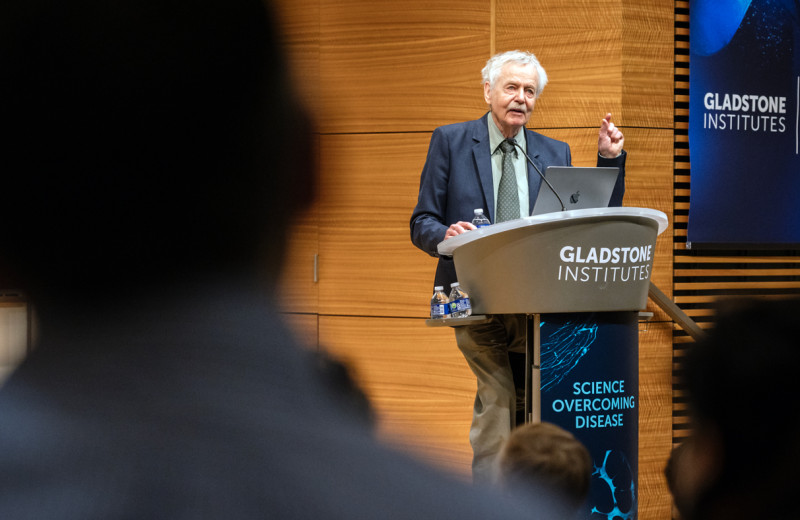Gladstone NOW: The Campaign Join Us on the Journey✕

From Puerto Rico to Gladstone, Yanilka Soto-Muñiz shares her journey in neuroscience, the inspiration she draws from trailblazing women, and her passion to advance patient care.
Yanilka Soto-Muñiz (she/her) is a graduate student in the lab of Ken Nakamura. She completed her bachelor’s degree in Puerto Rico, where she grew up, and majored in cellular and molecular biology at the University of Puerto Rico, Rio Piedras.
During her third year, she was awarded a fellowship from the National Institutes of Health Blueprint ENDURE program, which is tailored to expose students from historically underrepresented backgrounds to research in neuroscience. This program gave her the guidance and support to apply to graduate school.
What brought you to Gladstone?
Since I started doing research in neuroscience, I have been interested in understanding diseases and how we can develop new treatments. As a patient with Crohn’s disease, I understand the importance that research has in improving the quality of life for patients. Gladstone’s mission to understand disease is something that really resonated with me and I feel fortunate to be working in the lab of Ken Nakamura, who specializes in understanding energy metabolism in the brain and how it relates to neurological diseases.
Who has been your biggest influence in your scientific career?
I often think about the women who came before me and paved the way for us to be here right now. I had the opportunity to visit Marie Curie’s museum in Paris, France. She was the first woman to ever win the Nobel Prize and standing there, in what used to be her laboratory, was very inspiring. Marie Curie had to leave her country because women couldn’t pursue higher education at the time. When I think about Curie and other female scientists who came before me, I see not only their scientific achievements, but also the impact they had in allowing us, a younger generation of women, to be here now doing research. I feel very honored to be working at Gladstone alongside many brilliant women. It allows me to be my authentic self and grow as a scientist.
What drives you in your research, especially when facing challenges or setbacks?
I think stepping back to see the bigger picture really helps set you on track when facing challenges in research. Most of the time, things don’t work as we expect them to. Experiments fail very often, and it’s very easy to get lost in the details, but I have found that taking a moment to reflect on why we do what we do is really important to set you right on track again. Understanding that our work contributes to something greater, which is aiming to improve the quality of life for people living with diseases, drives me in my research.
How do advancements in technology impact the way you conduct your research?
Advancements in technology are crucial for research. Years ago, even doing research using isolated neurons was not trivial at all. Nowadays, thanks to advances in gene editing technology and reprogramming of cells, we can obtain virtually pure neurons to study in the lab in a matter of weeks.
I feel fortunate that some of the pioneers behind these technologies, like Shinya Yamanaka and Jennifer Doudna, are here at Gladstone. I’m excited to witness and contribute to the ongoing development of new technologies that enhance our understanding of diseases.
How does interdisciplinary collaboration enhance the quality and impact of your research?
At Gladstone, having several labs that focus on different aspects of disease allows us not only to learn about other scientific areas, but also to incorporate findings that can boost our own research. As we discover new insights in data science, neurological diseases, cardiovascular health, and virology, just to mention a few, we can integrate these diverse perspectives to create a more holistic understanding of complex health issues and, importantly, how we can address them. By leveraging the strengths of each lab, we amplify the quality and impact of our work, driving forward the goal we have of advancing human health.
You were living in Puerto Rico when Hurricane Maria hit the island. How did that experience impact your career trajectory?
I definitely remember my experience surviving Hurricane Maria, as basically all students on the island were affected by it. I had transferred from a smaller college campus in Aguadilla, Puerto Rico, to the main campus of the University of Puerto Rico at San Juan to have access to neuroscience laboratories. Unfortunately, shortly after, the laboratory I worked in was destroyed by Hurricane Maria. We didn’t have access to clean water or electricity for a while, and once it was safe to go back to school, I learned to be proactive and finished some experiments in other facilities to continue my research. The resilience and determination that I gained helped me get the NIH fellowship to work in the laboratory of Dr. Jimenez, where I did neuroscience research before moving to UC San Francisco (UCSF) to pursue my graduate education. I still carry with me the lessons learned and I am grateful for the resources we have access to at Gladstone and UCSF.
What do you do when you are not working?
I like exercising and exploring. The San Francisco Bay Area is very pretty, so I like enjoying the nature that surrounds us, and I especially like discovering new good spots for sunsets.
What is your hidden talent?
I can crochet. I started as a kid and now I like doing tops and hats.
What advice would you give to young scientists or students interested in your field?
To try it out! I think it’s really hard to know if you really like something without trying it first. There are programs that help high school and college students get exposed to careers in science, so taking advantage of those can be helpful to know if research is something you would be interested in pursuing as a career. I also think that talking to people who are currently doing research in your field of interest can be very insightful.
Want to Join the Team?
Our people are our most important asset. We offer a wide array of career opportunities both in our administrative offices and in our labs.
Explore CareersA Sculptor of Modern Regenerative Medicine
A Sculptor of Modern Regenerative Medicine
Among his myriad accomplishments, Rudolf Jaenisch—winner of the 2025 Ogawa-Yamanaka Stem Cell Prize—was the first to demonstrate the potential of induced pluripotent stem cells to treat disease.
Awards Ogawa Stem Cell Prize Profile Regenerative Medicine Stem Cells/iPSCsMeet Gladstone: Shijie Wang
Meet Gladstone: Shijie Wang
Shijie Wang, a postdoctoral scholar in Steve Finkbeiner’s lab, uses artificial intelligence, robotics, and stem cell technologies to uncover how brain cells die in neurodegenerative diseases like Alzheimer’s and Parkinson’s.
Profile Neurological Disease Finkbeiner Lab AI Robotic MicroscopyMeet Gladstone: Oscar Yip
Meet Gladstone: Oscar Yip
Oscar Yip is advancing Alzheimer’s research in Yadong Huang’s lab at Gladstone while drawing inspiration from his family, community, and his broader goal of helping patients.
Graduate Students and Postdocs Profile Alzheimer’s Disease



